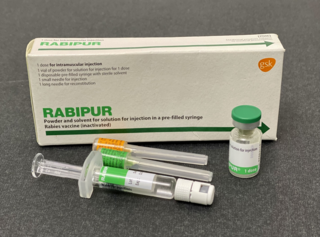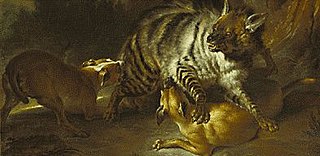Related Research Articles

A charmstone or coldstone is a stone or mineral artifact of various types associated with various traditional cultures, including those of Scotland and the native cultures of California and the American southwest. Typically they are elongated or cylindrical and have been shaped by grinding or other human activity, and may be perforated and/or grooved. They are thought to have been regarded as having some religious or magical function, including being talismans, amulets or charms.

An animal bite is a wound, usually a puncture or laceration, caused by the teeth. An animal bite usually results in a break in the skin but also includes contusions from the excessive pressure on body tissue from the bite. The contusions can occur without a break in the skin. Bites can be provoked or unprovoked. Other bite attacks may be apparently unprovoked. Biting is a physical action not only describing an attack but it is a normal response in an animal as it eats, carries objects, softens and prepares food for its young, removes ectoparasites from its body surface, removes plant seeds attached to its fur or hair, scratching itself, and grooming other animals. Animal bites often result in serious infections and mortality. Animal bites not only include injuries from the teeth of reptiles, mammals, but fish, and amphibians. Arthropods can also bite and leave injuries.
Bill Haast was the owner and operator, from 1947 until 1984, of the Miami Serpentarium, a tourist attraction south of Miami, Florida, where he entertained customers by performing live venom extraction from snakes. After closing the Serpentarium, he opened the Miami Serpentarium Laboratories, a facility in Punta Gorda, Florida that produced snake venom for medical and research use. Haast extracted venom from venomous snakes from the time he was a boy.
A snake-stone, also known as a viper's stone, snake's pearl, black stone, serpent-stone, or nagamani is an animal bone or stone used as folk medicine for snake bite in Africa, South America, India and Asia.

A dog bite is a bite upon a person or other animal by a dog, including from a rabid dog. More than one successive bite is often called a dog attack, although dog attacks can include knock-downs and scratches. Though some dog bites do not result in injury, they can result in infection, disfigurement, temporary or permanent disability, or death. Another type of dog bite is the "soft bite" displayed by well-trained dogs, by puppies, and in non-aggressive play. Dog bites can occur during dog fighting, as a response to mistreatment, by trained dogs working as guard, police or military animals, or during a random encounter.
The glaistig is a ghost from Scottish mythology, a type of fuath. It is also known as maighdean uaine, and may appear as a woman of beauty or monstrous mien, as a half-woman and half-goat similar to a faun or satyr, or in the shape of a goat. The lower goat half of her hybrid form is usually disguised by a long, flowing green robe or dress, and the woman often appears grey with long yellow hair. A sighting of the glaistig is rare, but the loud cries and wails would often be heard.

The rabies vaccine is a vaccine used to prevent rabies. There are a number of rabies vaccines available that are both safe and effective. They can be used to prevent rabies before, and, for a period of time, after exposure to the rabies virus, which is commonly caused by a dog bite or a bat bite.

Rabies is a viral disease that causes encephalitis in humans and other mammals. It was historically referred to as hydrophobia due to the symptom of panic when presented with liquids to drink. Early symptoms can include fever and tingling at the site of exposure. These symptoms are followed by one or more of the following symptoms: nausea, vomiting, violent movements, uncontrolled excitement, fear of water, an inability to move parts of the body, confusion, and loss of consciousness. Once symptoms appear, the result is virtually always death, regardless of treatment. The time period between contracting the disease and the start of symptoms is usually one to three months but can vary from less than one week to more than one year. The time depends on the distance the virus must travel along peripheral nerves to reach the central nervous system.

Hyena-baiting is a blood sport involving the baiting of hyenas against dogs.
Almost all human deaths caused by rabies occur in Asia and Africa. There are an estimated 59,000 human deaths annually from rabies worldwide.

In animals, rabies is a viral zoonotic neuroinvasive disease which causes inflammation in the brain and is usually fatal. Rabies, caused by the rabies virus, primarily infects mammals. In the laboratory it has been found that birds can be infected, as well as cell cultures from birds, reptiles and insects. The brains of animals with rabies deteriorate. As a result, they tend to behave bizarrely and often aggressively, increasing the chances that they will bite another animal or a person and transmit the disease.
Rabies has been the main plot device or a significant theme in many fictional works. Due to the long history of the virus as well as its neurotropic nature, rabies has been a potent symbol of madness, irrationalism, or an unstoppable plague in numerous fictional works, in many genres. Many notable examples are listed below.
Coyote attacks are events where coyotes attack humans. While uncommon and rarely cause serious injuries, they have been increasing in frequency, especially in the state of California. Although media reports of such attacks generally identify the animals in question as simply "coyotes", the perpetrators of some attacks may have been hybrids known as coywolves.
Puppy pregnancy syndrome (PPS) is a psychosomatic illness in humans brought on by mass hysteria. People suffering from PPS believe that shortly after being bitten by a dog, puppies are conceived within their abdomen. The syndrome is thought to be localized in villages in several states of India. Some psychiatrists believe that PPS meets the criteria for a culture-bound disorder.

A beaver attack is an attack on a human or domestic pet by a beaver. Beaver attacks are relatively uncommon but are becoming more frequently reported, as it is more common for humans to enter and disturb the natural habitat of these animals.

Animal attacks are violent attacks caused by non-human animals against humans, one of the most common being bites. These attacks are a cause of human injuries and fatalities worldwide. According to the 2012 U.S. Pet Ownership & Demographics Sourcebook, 56% of United States citizens owned a pet. In the United States in 1994, approximately 4.7 million people were bitten by dogs. The frequency of animal attacks varies with geographical location, as well as hormonal secretion. Gonad glands found on the anterior side of the pituitary gland secrete androgens and estrogens hormones. Animals with high levels of these hormones, which depending on the species can be a seasonal occurrence, such as during rutting season, tend to be more aggressive, which leads to a higher frequency of attacks not only to humans but among themselves. In the United States, a person is more likely to be killed by a domesticated dog than they are to die from being hit by lightning according to the National Safety Council.

Cat bites are bites inflicted upon humans, other cats, and other animals by the domestic cat. Data from the United States show that cat bites represent between 5–15% of all animal bites inflicted to humans, but it has been argued that this figure could be the consequence of under-reporting as bites made by Felis catus are considered by some to be unimportant. Though uncommon, cat bites can sometimes cause Rabies lead to complications and, very rarely, death.
A monkey bite is the bite of a monkey and is the second most common animal bite after dogs in India. Monkey bites account for 2–21% of animal bite injuries. Monkey bites are an important risk among travelers and after dog bites is the most common animal bite for travelers. Treatment depends upon many factors including the suspicion of rabies. Management involves:

The Sarawak rabies outbreak is an ongoing rabies outbreak in the state of Sarawak in Malaysia. Until 6 December 2022, 49 confirmed rabies cases and 44 deaths have been reported.
References
- 1 2 3 Way, Phocion R. (Autumn 1960). Duffen, William A. (ed.). "Overland via "Jackass Mail" in 1858: The Diary of Phocion Way (Part III)". Arizona and the West. Journal of the Southwest. 2 (3): 289. ISSN 0004-1408. JSTOR i40004452.
I have always been accustomed to look upon this disease as incurable, but here they have a stone which attracts the poison and when it is applied in time it never fails to cure.38 This fact is so well established that I cannot reasonably doubt it, and it should be known far and wide that others may profit by it.
- ↑ James Wooten, account of event told by family members and the bitten individual in the account.
- ↑ Randolf, Vance (1933). "Ozark Superstitions". Journal of American Folklore. 46 (179): 1–12. doi:10.2307/535847. JSTOR 535847.
The madstone treatment for rabies was once popular in many parts of the United States, and is still well known in the Ozarks. [...] I have never seen the madstone in actual use, but they tell me that if the dog was really mad the stone sticks fast to the wound and draws the "pizen" out.